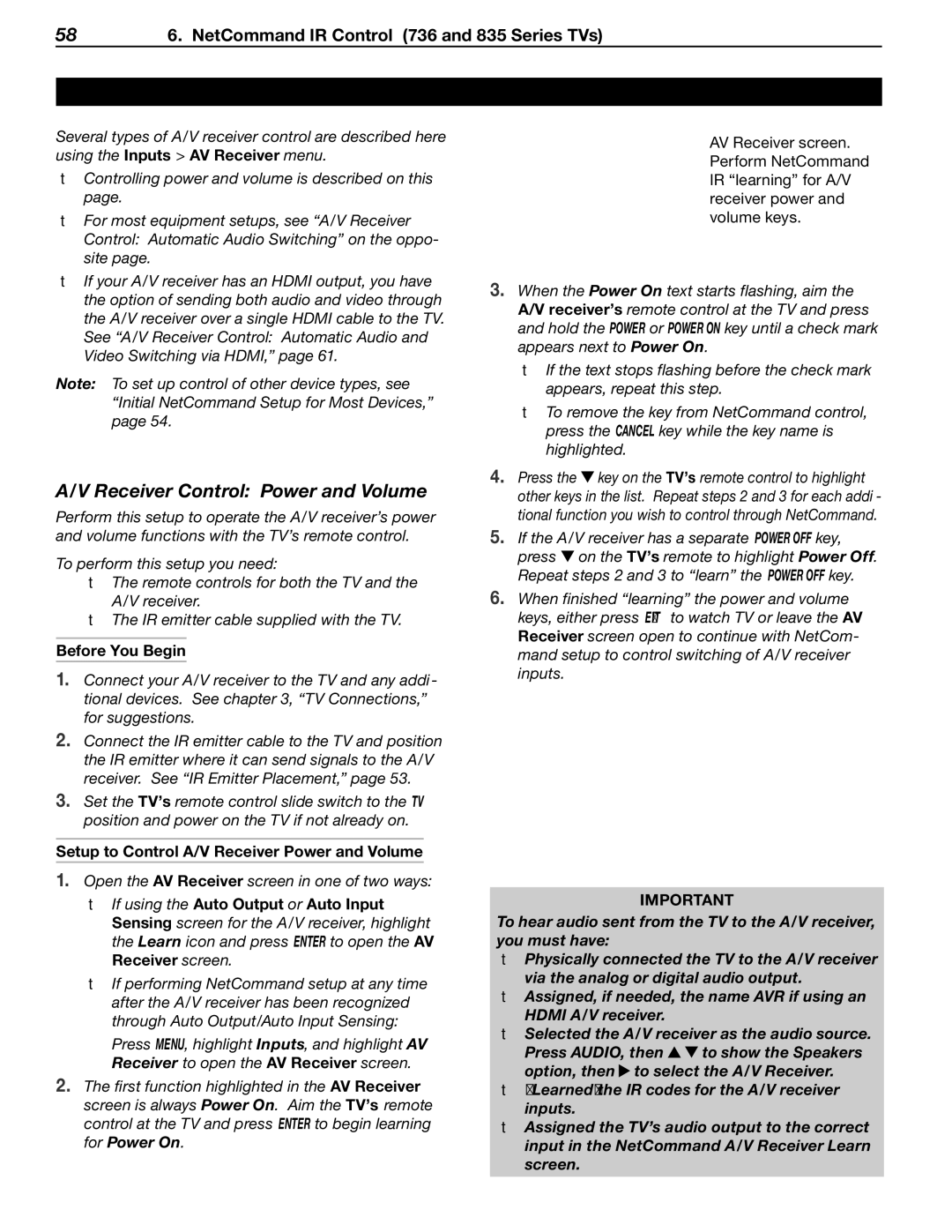
586. NetCommand IR Control (736 and 835 Series TVs)
Setting Up NetCommand Control of an A/V Receiver
Several types of A/V receiver control are described here using the Inputs > AV Receiver menu.
•Controlling power and volume is described on this page.
•For most equipment setups, see “A/V Receiver Control: Automatic Audio Switching” on the oppo- site page.
•If your A/V receiver has an HDMI output, you have the option of sending both audio and video through the A/V receiver over a single HDMI cable to the TV. See “A/V Receiver Control: Automatic Audio and Video Switching via HDMI,” page 61.
Note: To set up control of other device types, see “Initial NetCommand Setup for Most Devices,” page 54.
A/V Receiver Control: Power and Volume
Perform this setup to operate the A/V receiver’s power and volume functions with the TV’s remote control.
To perform this setup you need:
•The remote controls for both the TV and the A/V receiver.
•The IR emitter cable supplied with the TV.
Before You Begin
1.Connect your A/V receiver to the TV and any addi- tional devices. See chapter 3, “TV Connections,” for suggestions.
2.Connect the IR emitter cable to the TV and position the IR emitter where it can send signals to the A/V receiver. See “IR Emitter Placement,” page 53.
3.Set the TV’s remote control slide switch to the TV position and power on the TV if not already on.
Setup to Control A/V Receiver Power and Volume
1.Open the AV Receiver screen in one of two ways:
•If using the Auto Output or Auto Input Sensing screen for the A/V receiver, highlight the Learn icon and press ENTER to open the AV Receiver screen.
•If performing NetCommand setup at any time after the A/V receiver has been recognized through Auto Output/Auto Input Sensing:
Press MENU, highlight Inputs, and highlight AV Receiver to open the AV Receiver screen.
2.The first function highlighted in the AV Receiver screen is always Power On. Aim the TV’s remote control at the TV and press ENTER to begin learning for Power On.
AV Receiver screen. Perform NetCommand IR “learning” for A/V receiver power and volume keys.
3.When the Power On text starts flashing, aim the A/V receiver’s remote control at the TV and press and hold the POWER or POWER ON key until a check mark appears next to Power On.
•If the text stops flashing before the check mark appears, repeat this step.
•To remove the key from NetCommand control, press the CANCEL key while the key name is highlighted.
4.Press the ![]() key on the TV’s remote control to highlight other keys in the list. Repeat steps 2 and 3 for each addi- tional function you wish to control through NetCommand.
key on the TV’s remote control to highlight other keys in the list. Repeat steps 2 and 3 for each addi- tional function you wish to control through NetCommand.
5.If the A/V receiver has a separate POWER OFF key, press ![]() on the TV’s remote to highlight Power Off. Repeat steps 2 and 3 to “learn” the POWER OFF key.
on the TV’s remote to highlight Power Off. Repeat steps 2 and 3 to “learn” the POWER OFF key.
6.When finished “learning” the power and volume keys, either press EXIT to watch TV or leave the AV Receiver screen open to continue with NetCom- mand setup to control switching of A/V receiver inputs.
IMPORTANT
To hear audio sent from the TV to the A/V receiver, you must have:
•Physically connected the TV to the A/V receiver via the analog or digital audio output.
•Assigned, if needed, the name AVR if using an HDMI A/V receiver.
•Selected the A/V receiver as the audio source.
Press AUDIO, then ![]()
![]() to show the Speakers option, then
to show the Speakers option, then ![]() to select the A/V Receiver.
to select the A/V Receiver.
•“Learned” the IR codes for the A/V receiver inputs.
•Assigned the TV’s audio output to the correct input in the NetCommand A/V Receiver Learn screen.
